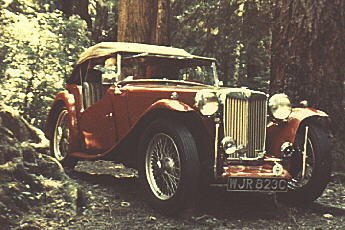MG TC


 Click here to add your MG News.
Click here to add your MG News.


 Click here to add your MG News.
Click here to add your MG News.
In 1958 John purchased his car from Graham Keillerup. Prior to Johnís purchase, the car was road registered and used very successfully as a weekend racer, winning in the late 1950ís something called the M.G. Road Racing Championship, however no details of this claim are available.

During the fifties the car ran both unblown and blown, equipped with the Shorrock supercharger which can be seen hanging out the side of the bonnet in the shot of the car at Templestowe hillclimb a few months before it was purchased. After looking at lots of TCs (there were lots available in those days) John paid £485, which did not include the good engine or the blower.
In fact, it didnít have much of an engine at all when John bought it, but more of that later. It was otherwise a good basic TC, with standard engine, full guards, Singer Nine bucket seats, painted cream with house paint, battery box removed from the scuttle and the battery box removed from the scuttle and the battery moved back behind the rear wooden bulkhead and telescopic dampers all round. The front springs had one leaf less and were set up higher. The rear springs were tied, so the car rode differently but with teles fitted it felt good except that the rear springs bottomed easily.
So it was a good basis for what John wanted. He advertised in Australian Motor Sport magazine for a Marshall J75 blower but the kit he found had an inadequate drive set up and a 13/8Ē SU carburettor, so it produced only about two punds boost. Mixture also wasnít right but the late Barry Papps (the master needle filer) got him going on an interim basis and the car did a seventeen second dead, standing quarter at one of the old Fishermanís Bend sprint meetings (at the time John felt there must have been a timing error but he didnít let on). It did prove, however, that a well set up car with suitable gearing could be quicker than some of the clever cars that were never quite right.
Unfortunately the engine didnít last long. When it was opened it was found to be fitted with Repco four-ring pistons which have been Knurl-sized instead of being replaced. (Knurl-sized was a proprietary process used to revive worn pistons at the time). Brian Sampson overhauled the engine and did some cylinder head work - in fact it was one of the very first engines Brian built after he felt his fatherís business to start Motor Improvements.
Shortly after this, in about 1959, the car was severely deformed by a drunk running a red light in two tons (this was pre-tonnes) of Dodge Phoenix. So John set to with a new chassis which came from under Harry Fordís house. Les Thurgood boxed and strengthened the chassis and Peter Thomas steel framed the body. John came across a TF 1500 block and the engine was rebuilt again round that.
The cylinder head ports were opened up so you could almost put your fists in them - indeed today you can now look down the ports and see the valves. The blower was made to run faster using twin A-section belts and a new carburettor manifold was made to accept a 13/4Ē SU. A second-hand extractor exhaust system completed things and the car proved to be very fast for a fully equipped road-going square rigger. It was all a bit much for super petrol, but fortunately there were roadside pumps selling 100 octane and sometimes Avgas. You could also buy Benzol at BP stations, but with the gradual withdrawal of these products either a compression ratio reduction or water injection became necessary. After looking at the many off-the-shelf units then available John decide to build his own system which used blower manifold pressure to deliver the water with some simple valving to control it. The system worked well and is still fitted to the car.
Many other modifications have been made over the years, including a conversion in 1960 or 61 to rack and pinion steering using a Triumph Herald rack. The triumph rack is lighter and more compact than a BMC rack and has the further advantage that it is designed to go ahead of the axle. This allowed it to be shortened by about six inches and to mount it upside down on the right hand side of the chassis, using only one end of the rack to connect to the drag link, where it preserves the original geomtry and provides the best steering it is possible to get from a TC.
Some 20 years ago, following another major collision in which John was lucky to survive, the car was started on its third incarnation, but divorce and lack of facilities (and funds) meant the rate of progress was so slow that John was unlikely to live long enough to see the project completed. So he was very pleased when Geoff Norwell, who had just built an exact replica of his own TC, the most notable of which was the Bicentennial event at Oran Park in 1988. As a result John owes Geoff many drives in his car.
For a while, progress was rapid, but then Geoffís real business began to intrude and the car was moved to David Lower who has done some amazing work, including a completely new blower manifold and exhaust system. The car is due to emerge just before or just after Christmas (1955), depending on trimming and when the final painted bits such as the cycle guards and stanchions come back.
In Johnís hands the TC has run at Calder, Winton, Templestowe, Rob Ray, Mount Martha and Fishermanís Bend and in lots of rallies and motorkhanas. The plan is to give it more of the same.
Johnís most notable outing was in a Mount Martha hill climb event organised by the M.G.C.C when John beat Fritz Norden in 1962. Like the famous original axe, not much is left of the car which left the factory nearly fifty years ago, but it has a good history and continuous ownership and it will probably now survive forever.
Johnís goal is to compete regularly in future, first outing to be Eastern Beach Sprints and then in circuit races and historic racing register events like Mangalore Sprints, Hillclimbs at Morwell, Tarrengower and Rob Roy.
Now, to help you date your car, a summary of TC and TD production dates, which Iíve lifted from M.G. Talk, the South-eastern T-Registerís Newsletter.
TC Production dates
| 1945 | 1946 | 1947 | 1948 | 1949 | |
| Jan | 1 0352 | 1 1052 31 0432 |
5 4412 31 2281 |
5 7503 29 4667 |
31 7775 |
| Feb | 5 0433 28 0512 |
3 2282 10 2341 |
2 4668 26 4902 |
1 7776 25 8038 | |
| Mar | 5 0513 27 0600 |
5 2342 31 2490 |
1 4903 31 5140 |
3 8039 31 8335 | |
| Apr | 1 0601 30 0711 |
1 2491 30 2681 |
1 5141 30 5397 |
1 8336 28 8571 | |
| May | 1 0712 31 0871 |
1 2682 30 2881 |
4 5398 28 5608 |
2 8572 31 8858 | |
| Jun | 3 0872 28 1031 |
2 2882 30 3101 |
1 5609 30 5911 |
1 8859 30 9127 | |
| Jul | 7 1032 26 1181 |
2 3102 24 3281 |
1 5912 23 6150 |
1 9128 22 9329 | |
| Aug | 12 1182 29 1301 |
11 3282 29 3451 |
10 6151 31 6374 |
8 9330 31 9566 | |
| Sep | 12 0252 28 0272 |
2 1302 28 1501 |
1 3452 30 3681 |
1 6375 30 6701 |
1 9567 30 9845 |
| Oct | 16 0273 30 0285 |
2 1502 31 1711 |
1 3682 30 3951 |
1 6702 29 6976 |
3 9846 27 10065 |
| Nov | 1 0268 26 0315 |
1 1712 29 1887 |
3 3952 26 4171 |
3 6977 26 7244 |
1 10066 29 10251 |
| Dec | 6 0316 21 0351 |
2 1888 31 2051 |
1 4172 31 4411 |
1 7245 24 7502 |
TD Production dates
| 1949 | 1950 | 1951 | 1952 | 1953 | |
| Jan | 2 0349 31 3612 |
1 5170 31 5799 |
1 12578 31 13374 |
1 23645 30 24631 | |
| Feb | 1 0613 28 0838 |
2 5800 28 6391 |
1 13375 28 14064 |
2 24632 27 25623 | |
| Mar | 1 0839 31 1173 |
1 6392 30 6948 |
3 14085 31 14797 |
2 25624 31 26487 | |
| Apr | 3 1174 28 1469 |
3 6949 27 7467 |
1 14798 30 15561 |
1 26488 30 27285 | |
| May | 1 1470 31 1846 |
1 7468 31 8041 |
1 15562 30 16746 |
1 27286 29 28127 | |
| Jun | 1 1847 30 2320 |
1 8042 29 9701 |
4 16747 30 17646 |
3 28128 30 28964 | |
| Jul | 3 2321 28 2822 |
2 8702 26 9362 |
1 17647 25 18606 |
1 28965 24 29723 | |
| Aug | 14 2823 31 3058 |
13 9363 31 9928 |
11 18607 29 19345 |
10 29724 17 29915 | |
| Sep | 1 3059 29 3592 |
3 9929 28 10655 |
1 19346 30 20433 |
||
| Oct | 2 3593 31 4123 |
1 10656 30 11322 |
1 20434 31 21587 |
||
| Nov | 10 0251 25 0273 |
1 4124 30 4724 |
1 11323 30 12100 |
3 21588 28 22612 |
|
| Dec | 5 0274 20 0348 |
1 4725 22 5169 |
3 12101 20 12577 |
1 22613 31 22634 |
More on MG T Types
T Type Gallery
MGCC Home Page
MG TC Parts
MG TD Parts
MG TF Parts
MG T Series Top
MG T Series Tonneau
MG T Series Books
 Back to the News content
Back to the News content
![[Copyright/Credits]](../pics/mini-copyright.gif)
![[Home]](../pics/mini-home.gif)
![[Information]](../pics/mini-info.gif)
![[Feedback]](../pics/mini-mail.gif)